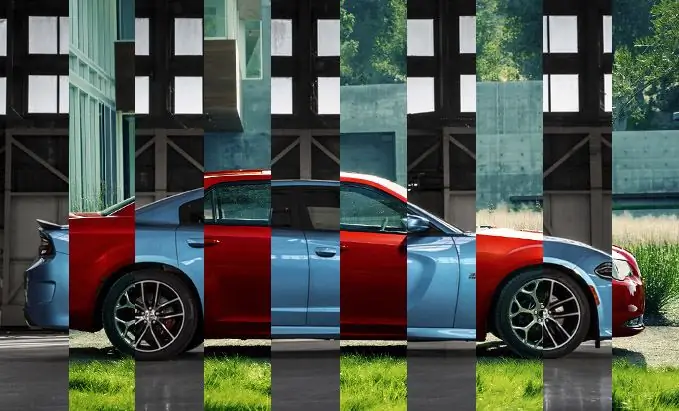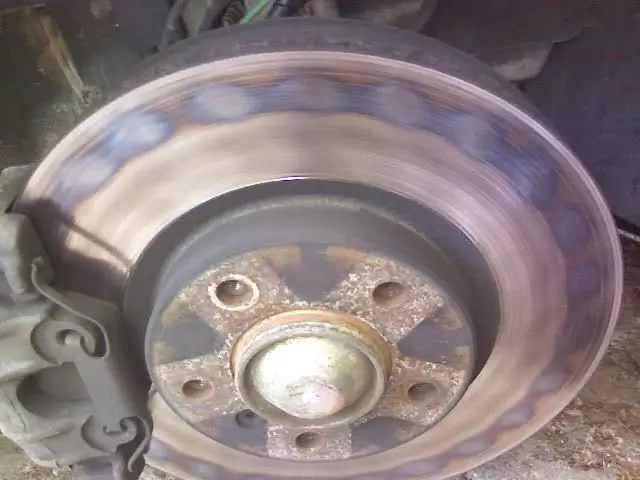2026 Author: Erin Ralphs | [email protected]. Last modified: 2025-01-22 21:14:16
Suspension is the part of the car that most often wears out on our roads. Silent blocks, stabilizer bushings, levers and shock absorbers are usually associated with the chassis. But today we will not talk about them. In this article, we will pay attention to the wheel bearing. It is an integral element in every car, regardless of what type of suspension it uses. What are the signs of a malfunction of this part and how is the wheel bearing replaced? Let's find out all this right now.
Signs
How can I tell if my car needs a wheel bearing replacement? Everything is very simple. It is necessary to make a small test drive on the road with long turns. Having accelerated to a speed of 40 or more kilometers per hour, when entering a turn, you will notice a characteristic hum (like an electric train) that is heard in one of the parts of the cabin. How to determine exactly which side of the bearing is worn? If the rumble comes from the right side when the steering wheel is turned to the left, then your right wheel bearing has become unusable. The higher the load on this element (and when turning it increases several times), the strongerthis detail will buzz. Thus, it is possible to determine whether a VAZ car needs a wheel bearing replacement without diagnostic stands.

Please note that when a breakdown is detected, do not hesitate to fix the problem. A crumbling bearing can simply jam at one moment. At speed, the wheel will lock up and the driver will suddenly lose control.
Tools
In order for the hub bearing replacement to be successful, we need to prepare:
- Jack and wheel wrench.
- New bearing. Please note: if your car is equipped with ABS, then the element must also be designed to work with ABS. Other bearings must not be installed. This is often found on budget foreign cars. They are not always equipped with an ABS system, which is why the bearings are different (Ford Focus can be used as an example).
- New nut and circlips.
- Puller.
- Screwdriver.
- Round nose pliers (may be useful for removing the stopper).
- Grease ("Litol-24").
- Vise and a piece of pipe one meter long (will serve as a lever).

Work should be done indoors and well lit.
About the puller
Before starting work, you should think about how best to remove this element. Experts recommend performing this operation with a puller. Often these devices are universal and suitable for different brands of cars. The cost of suchthe tool is relatively small (up to a thousand rubles), but it will greatly facilitate the work. With the help of a puller, you can carefully dismantle the bearing without damaging the critical components in the machine. In work, you should not use brute force, and even more so use a sledgehammer with a punch.

The puller is based on a steel rod, which is connected to several metal paws (usually two or three) for gripping. The paws can be deployed to remove the element. Such pullers are mechanical, but professional service stations use more advanced hydraulic counterparts. Also note that the replacement of the bearing of the front hub and the rear has its own differences. Therefore, we will consider each side separately.
Replacing the front hub bearing
So let's get to work. The operation must be performed on a level, firm and dry surface.

In this case, the car itself must be on the handbrake and in gear (for reliability, you can put wheel chocks). After that, using a slotted screwdriver, remove the bearing cap. Next, we tear off the hub nut, but do not completely unscrew it.
What should I do next?
Since we need to get access to the hub, we break off the disk bolts. Next, we jack up the front of the car from the right side and get the wheel out. After that, unscrew the hub nut completely. Then the previously acquired puller is used. We fix it in place with paws andWe begin to carefully press out the old bearing. It is important to inspect the seat after it is dismantled. Often the consequence of bearing wear is the presence of water and dirt, which provokes increased wear and corrosion. In order for the new element to last as long as possible, the seat should be completely cleaned of these components. Any solvent and even gasoline will help us here. Next, apply new grease to the area and install the bearing into the hub using a vise. It is important to avoid distortion. The element should stand as straight as possible. At the end, the bearing is fixed on the axle with a thrust washer and nut. To eliminate backlash, tighten the hub nut. But be careful - you need to tighten with a certain effort. It is better to do this with a torque wrench. The tightening torque for each vehicle is individual and is indicated in the owner's manual.

At the end of the work, we put the wheel in place and make a test run. It is important to listen to the operation of the bearing. It should not make noise or vibration. If all is well, the work can be considered successfully completed.
Replacement rear wheel bearing
As experience shows, this operation is a little easier than in the case of the front. So, how is a rear wheel bearing replaced? In the first step, we need to loosen the hub nut. Similarly, we set the car to first gear (but do not use the handbrake). Then we put the car on a jack, having previously torn off the bolts on the disk itself. Then take the wheel out andusing a slotted screwdriver, remove the protective cap.
Next, using a hexagon, unscrew the pins that hold the brake drum. We remove the cover. It is not necessary to dismantle the pads themselves. If the pins do not unscrew, you can apply a liquid wrench lubricant. Next, unscrew the hub nut and remove the washer. Then we take a puller in our hands. We install the device on the axis with an emphasis. With the help of paws we hook on the back side of the hub. Next, tighten the threaded connection with a wrench. Thus, the hub can be easily removed and a bearing ring with a separator and balls will remain inside. The inner ring from the axle shaft must be pulled off with a bearing. Next, we press out the old parts, having previously removed the stopper with round-nose pliers.
How to remove the old element?
At the next stage, remove the protective cover and clamp the hub in a vise. Carefully knock off the lid. The outer clip can be pressed out by selecting the head of the desired diameter (usually about 60 millimeters). To make the bearing come out on the other side, you can additionally use spacers.
Installation
How is the hub bearing replaced next? At the very beginning of work, it is important to clean the seat. As with replacing the front wheel bearing, here you can use gasoline or white spirit. Having completely cleared the area of dirt, rust and dust, we proceed to pressing.

Here it is important to observe the smoothness of the effort and make sure that the element sits without distortions. Tighten the part in tesk and press it all the way until the elementwill not fully fit into the body. For convenience, you can use the old bearing race. It fits perfectly on the inner diameter and will not allow misalignment.
After that, install the hub in reverse order, tighten the nut, put the drum and the wheel in place. Don't forget to install the protective cap. This is an important element that protects the bearing from damaging components such as water and dust. After replacing the wheel bearing, it is recommended to make a test drive, preferably at a speed of more than 60 kilometers per hour. So we will determine how smoothly the bearing entered the housing and whether there are any extraneous vibrations.
Recommendations
When replacing the front hub bearing (it is a VAZ or a foreign car, it does not matter), it is important to observe the correct tightening of the nut. As we said earlier, this can be done with a torque wrench. However, not everyone has it. How then to be? There is a way out.

In the absence of such a key, it is necessary to tighten the nut until it stops. And then it needs to be loosened by 60 degrees. After replacing the front wheel bearing, rotate the wheel and check for excessive noise or grinding. If there are any signs, it is recommended to loosen the nut. But you need to loosen it so as to eliminate the play of the wheel itself. Otherwise, at speed it can cause insane vibrations that are transmitted to the steering wheel and to the entire body. But a small backlash is still allowed. Why? It's simple: if the bearing is tightly tightened, it will overheat. Because of this, the lubricant inside it heats up. As a consequence, the bearing is no longer lubricated and fails prematurely. Also, experts recommend putting a protective cap on the sealant.
Recommended:
What is the difference between front-wheel drive and rear-wheel drive: the difference, advantages and disadvantages of each

Among car owners, even today, disputes about what is better and how front-wheel drive differs from rear-wheel drive do not subside. Each gives his own arguments, but does not recognize the evidence of other motorists. And in fact, it is not easy to determine the best type of drive among the two options available
What is a connecting rod bearing? Main and connecting rod bearings

The crankshaft of the engine is a body of rotation. He rotates in special beds. Plain bearings are used to support it and facilitate rotation. They are made of metal with a special anti-friction coating in the form of a half ring with precise geometry. The connecting rod bearing works like a plain bearing for the connecting rod, which pushes the crankshaft. Let's take a closer look at these details
Adjusting wheel alignment. How to adjust wheel alignment yourself. Wheel alignment stand

Today, any service station offers wheel alignment adjustment. However, car owners can carry out this procedure on their own. So they will learn to better understand and feel their car. Auto mechanics unanimously argue that it is extremely difficult to set up a wheel alignment on your own. Actually it's not like that
Why does the steering wheel vibrate when braking on the VAZ-2110, Chevrolet Lacetti, Opel Astra? Steering wheel vibrates when braking at speed

A car is a vehicle of increased danger. When driving, all controls must be in good working order. However, it happens that the steering wheel vibrates when braking. Opel Astra is also not immune from such a problem. Let's look at the causes of this malfunction and how to fix them
Steering technique: turning the steering wheel when turning. Creaking, crunching when turning the steering wheel, what do they mean

Few drivers think about, for example, how correctly they hold the steering wheel, considering this an unimportant nuance that does not affect the quality of driving; Or what should be the turn of the steering wheel when turning. In fact, there is a whole technique for handling the steering wheel

